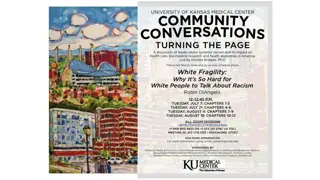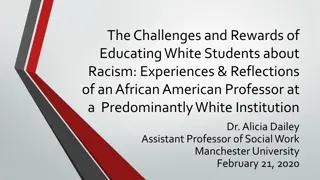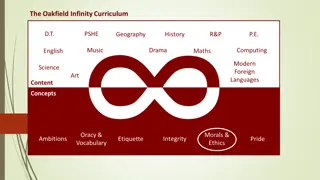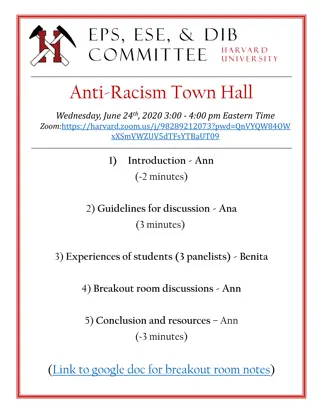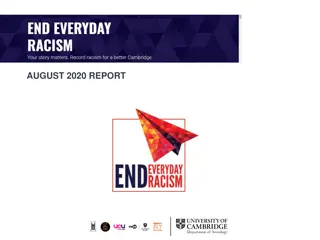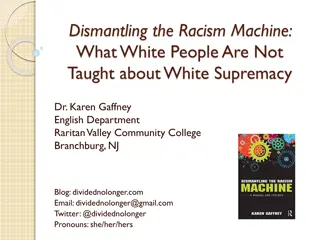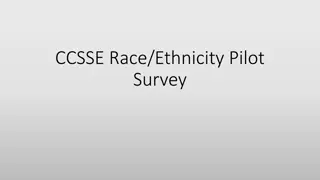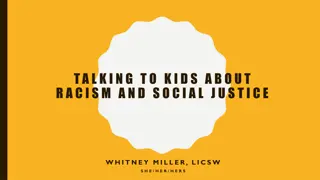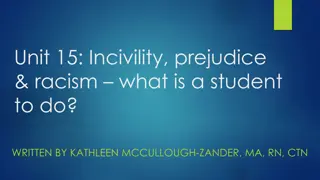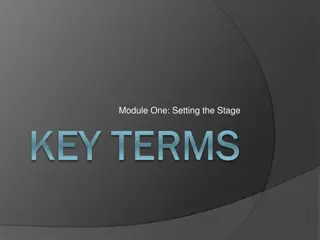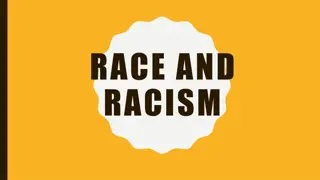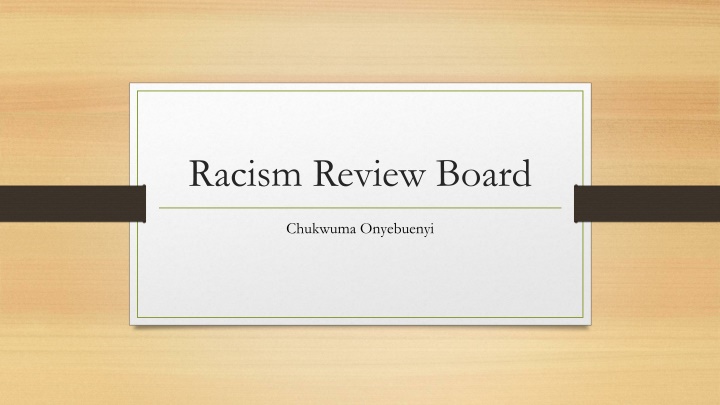
Addressing Racism in Medicine: Impact, History, and Initiatives
Learn about the Racism Review Board led by minority students aiming to create a more racially conscious medical school curriculum. Explore the historical context and importance of addressing racism in medicine, highlighting disparities, unethical studies, and the impact on health outcomes for marginalized communities.
Download Presentation

Please find below an Image/Link to download the presentation.
The content on the website is provided AS IS for your information and personal use only. It may not be sold, licensed, or shared on other websites without obtaining consent from the author. If you encounter any issues during the download, it is possible that the publisher has removed the file from their server.
You are allowed to download the files provided on this website for personal or commercial use, subject to the condition that they are used lawfully. All files are the property of their respective owners.
The content on the website is provided AS IS for your information and personal use only. It may not be sold, licensed, or shared on other websites without obtaining consent from the author.
E N D
Presentation Transcript
Racism Review Board Chukwuma Onyebuenyi
What is the Racism Review Board? Is a group led by minority students of color (most drastically affected by racism) whose main objective is to continuously create a more racially conscious medical school curriculum. A curriculum that better incorporates new and contemporary research on how racism and medicine interact where the curriculum currently at the institution falls short. A curriculum that better addresses the current flaws imbued in the current curriculum.
Why is it important to address racism in Medicine? 1839 - Races skull size and shape. 1847 - John fed Brown April 4 2016 UVA study on white medical students. https://news.virginia.edu/content/study-links-disparities-pain-management-racial-bias 1851 - Dr. Samuel Cartwright and pseudoscience Drapetomania Dysthesia Aethiopica Herbetude Cachexia Africana Different cure for black and white people
Why? Mid 1800s - Dr. James Marion Sims - Black infants and woman 1700,1800, 1900s - Intentional moving of Medical schools to inner cities. 1900s - Mississippi Appendectomy forced sterilization of Black women. 1910 - Flexner report and HBCUs 1916 - Eugenics and Madison Grant.
Why? 1932-1972 - Tuskegee Syphilis study 1945 - Ebb Cade 1950s and 70s - Black prisoners in Holmesburg prison 1960s-1970s - Black boys, violence, and curative lobotomies 1987-1991 - EZ measles virus and LA In the 1990s - Fenfluramine is the cure for inner city violence.
Racism and Medicine The disparities of today are a direct result of Medicine s history. Medical Apartheid Excerpt African Americans share the most deplorable health profiles in the nation by far, one the resembles Third World Countries Twice as many African American babies as babies of other ethnic groups die before their first birthday 1.5x more African American adults dies in comparison to European American adults. Black individuals have dramatically higher rates or nearly every cancer, AIDS, of heart disease, of diabetes, liver disease, and infectious disease.
3 non white block directors/PD/PCC course Directors out of 37 None of which are Black. https://www.med.unc.edu/md/curriculum/tec-curriculum-information/foundation- phase/foundation-phase-semester-1 https://www.med.unc.edu/md/curriculum/tec-curriculum-information/foundation- phase/foundation-phase-semester-2 https://www.med.unc.edu/md/curriculum/tec-curriculum-information/foundation- phase/foundation-phase-semester-3
Whats available now to address racism? Limitations? SNMA Dismantling Racism Coalition PD
What is the Racism Review Board? The Racism Review Board is a Curriculum Oriented Group This group is split between: Curriculum Review Curriculum Architect Racism Review Book Group
Logistics The group I propose should work either as a separate student run organization, a student run organization under SNMA, or as a student organization under the Office of Special Programs. Each of these approaches impact recruiting. If a solo student org, previous org leaders will decide by an interview process who the new members on the board would be. If under SNMA, previous org leaders can decide the predecessors on the board or SNMA members can vote in who will be represented on the board. If under OSP any of the previous electoral ideas could be adopted or OSP can also play a direct role in choosing which students will be represented on the board by an interview process.
Drawbacks of each approach Solo student run organization. Pro Reason: We are independent and fully get to capitalize on our status as consumers. There would be no institutional pressure outside of our educational standings as students versus being under an employee or national organization s chapter. Con Reasons: Putting it as a solo student org runs the risk of it not being picked up by students. Who s Chukwuma to create such an initiative? Prestige, Time commitment versus CV, Students of color are already marginalized in this space so it runs the risk of alienating students who are already alienated. Also will range in dedication of students from year to year. In years of no interest, group will be extremely ineffective or possibly extinct because there is no people power or institutional backing to keep it alive.
Drawbacks of each approach Student run organization under SNMA Pro Reason: SNMA already has an organization comprised of most of the black medical students on campus. This allows more easy feedback from black students to the group and more consolidation of voices as it pertains to addressing the issues that would be addressed by the board. Institutionalized through a predominantly black organization. Possible funding availability. Con Reasons: Putting it under SNMA at UNC goes against the years long ongoing policy of multiculturalism that SNMA embodies shying away from specifically representing race. A quote that can be frequently heard by leaders of the groups is This is not the black group it is for everyone . This prevents the students within this group from being more direct and specific on how racism in particular impacts this space for fear of alienating their more multicultural branding.
Drawbacks of each approach Student run organization under OSP Pro Reasons: Prestige since the group is institutionalized. Looks better on a CV for students interested. More professional backing and guidance when issues arise. Building of professional connections as it pertains to career development in these interests. Possible funding availability. Con Reasons: Putting it under OSP puts the office directly responsible or in the line of fire for every idea that comes out of the group. Since OSP is made up of UNC SOM employees there is a power dynamic that does endanger people in the office as it pertains to the students work. This may prevent students within this group from being more direct and specific on how racism in particular impacts this space.
Conclusion This group is heavily needed on campus. There is not a specific impetus for the curriculum to evolve and incorporate modern research and academic data as it pertains to racism in medicine. At UNC with board directors, TEC and PD curriculum directors, professors, and racism specific student groups being overwhelmingly white in these spaces, a specific group of students of color empowered in this space pushing the needle on how racism is addressed is critically needed. Otherwise patients for the foreseeable future will be continuously affected by the same health disparities.



